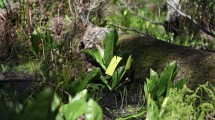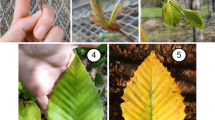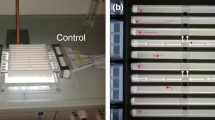Abstract
Seven electrophysiologically active compounds were detected in air-entrained headspace samples of live flowers of Tagetes erectaanalyzed by gas chromatography (GC) linked to a female Helicoverpa armigeraelectroantennograph (EAG) using polar and nonpolar capillary columns. These compounds were subsequently identified using GC linked to mass spectrometry as benzaldehyde, (S)-(−)-limonene, (R,S)-(±)-linalool, (E)-myroxide, (Z)-β-ocimene, phenylacetaldehyde, and (R)-(−)-piperitone. Electrophysiological activity was confirmed by EAG with a 1-μg dose of each compound on filter paper eliciting EAG responses that were significantly greater than the solvent control response from female moths. Wind-tunnel bioassays with T. erectaheadspace samples, equivalent to 0.4 flower/hr emission from a live flower, elicited a significant increase in the number of upwind approaches from female H. armigerarelative to a solvent control. Similarly, a seven-component synthetic blend of EAG-active compounds identified from T. erectapresented in the same ratio (1.0 : 1.6 : 0.7 : 1.4 : 0.4 : 5.0 : 2.7, respectively) and concentration (7.2 μg) as found in the natural sample elicited a significant increase in the number of upwind approaches relative to a solvent control during a 12-min bioassay that was equivalent to that elicited by the natural T. erectafloral volatiles.
Similar content being viewed by others
REFERENCES
ADAMS, R. P. 1995. Identification of Essential Oil Components by Gas Chromatography/Mass Spectrometry. Allured Publishing, Carol Stream, Illinois.
ARMES, N. J., BOND, G. S., and COOTER, R. J. 1992. The laboratory culture and development of Helicoverpa armigera. Natural Resources Inst. Bull. 57. Natural Resources Institute, Chatham, UK.
BLANEY, W. M., and SIMMONDS, M. S. J. 1990. The role of chemicals from legumes in mediating host selection by adults and larvae of Helicoverpa armigera: A behavioural and electrophysiological study, inHost Selection Behaviour of Helicoverpa armigera. Summary Proceedings of the First Consultative Group Meeting, March 5-7, 1990, ICRISAT Center. ICRISAT, Patancheru, India.
BRANTJES, N. B. M. 1978. Sensory responses to flowers in night-flying moths. InA. J. Richards (ed.). The Pollination of Flowers by Insects. Academic Press, London.
BRUCE, T. J., CORK, A., HALL, D. R., and DUNKELBLUM, E. 2001. Laboratory and field evaluation of floral odours from African marigold, Tagetes erecta, and sweet pea, Lathyrus odoratus, as kairomones for the cotton bollworm Helicoverpa armigera. IOBC Bulletin Vol. 24. Proceedings of a conference, “Use of Pheromones and Other Semiochemicals in Integrated Control.” September 2000.
BURGUIÈRE, L., MARION-POLL, F., and CORK, A. 2001. Electrophysiological responses of female Helicoverpa armigera(Hubner) (Lepidoptera, Noctuidae) to synthetic odours. J. Insect Physiol.47:509-514.
BUTTERY, R. G., and LING, L. C. 1984. Corn leaf volatiles: identification using tenax trapping for possible insect attractants. J. Agric. Food. Chem.32:1104-1106.
BUTTERY, R. G., LING, L. C., and TERANISHI, R. 1980. Volatiles of corn tassels: Possible corn ear worm attractants. J. Agric. Food Chem.28:771-774.
BUTTERY, R. G., LING, L. C., and LIGHT, D. M. 1987. Tomato leaf volatile aroma components. J. Agric. Food Chem.35:1039-1042.
CORK, A., BEEVOR, P. S., GOUGH, A. J. E., and HALL, D. R. 1990. Gas chromatography linked to electroantennography: A versatile technique for identifying insect semiochemicals, pp. 271-279, inA. R. McCaffery and I. D. Wilson (eds.). Chromatography and Isolation of Insect Hormones and Pheromones. Plenum Press, London.
ETIEVANT, P. X., AZAR, M., PHAM-DELEGUE, M. H., and MASSON, C. J. 1984. Isolation and identification of volatile constituents of sunflowers (Helianthus annusL.) J. Agric. Food Chem.32:503-509.
FIREMPONG, S., and ZALUKI, M. P. 1990. Host plant selection by Helicoverpa armigera: Role of certain plant attributes Aust. J. Zool. 37:675-683.
FITT, G. P. 1989. The ecology of Heliothisspecies in relation to agroecosystems Annu. Rev. Entomol. 34:17-52.
FLATH, R. A., FORREY, R. R., JOHN, J. O., and CHAN, B. G. 1978. Volatile components of corn silk (Zea maysL.): possible Heliothis zea(Boddie) attractants. J. Agric. Food. Chem.26:1290-1293.
FORRESTER, N. W., CAHILL, M., BIRD, L. J., and LAYLAND, J. K. 1993. Management of pyrethroid and endosulphan resistance in Helicoverpa armigera(Lepidoptera: Noctuidae) in Australia. Bull. Entomol. Res.Suppl. 1.
GABEL, B., THIÈRY, D., SUCHY, V., MARION-POLL, F., HRADSKY, P., and FARKAS, P. 1992. Floral volatiles of Tanacetum vulgareL. attractive to Lobesia botranaDen. and Schiff. females. J. Chem. Ecol.16:701-711.
GUPTA, Y. N., and BHANDARI, K. S. 1974. Chemical examination of essential oil from the flowering tops of Tagetes erecta. Indian Perfumer18:29-33.
HAYNES, K. F., ZHAO, J. Z., and LATIF, A. 1991. Identification of floral compounds from Abelia grandiflorathat stimulate upwind flight in cabbage looper moths. J. Chem. Ecol.17:637-646.
KEVAN, P. G., and BAKER, H. G. 1983. Insects as flower visitors and pollinators. Annu. Rev. Entomol.28:407-453.
KöNIG, W. A., KREBBER, R., EVERS, P., and BRUHN, G. 1990. Stereochemical analysis of constituents of essential oils and flavour compounds by enantioselective capillary gas chromatography. J. High Resolut. Chromatogr. 13:328-332.
LANDOLT, P. J., LENCZEWSKI, B., and HEATH, R. R. 1991. Lure and toxicant system for the cabbagelooper (Lepidoptera, Noctuidae). J. Econ. Entomol. 84:1344-1347.
LOUGHRIN, J. H., HAMILTON-KEMP, T. R., ANDERSEN, R. A., and HILDEBRAND, D. F. 1990. Headspace compounds from flowers of Nicotiana tabacumand related species. J. Agric. Food Chem.38:455-460.
MILLER, J. R., and ROELOFS, W. L. 1978. Sustained-flight tunnel for measuring insect responses to wind-borne sex pheromones. J. Chem. Ecol.4:187-198.
MOORHOUSE, J. E., Y EADON, R., BEEVOR, P. S., and NESBITT, B. F. 1969. Method for use in studies of insect chemical communication. Nature223:1174-1175.
PATEL, R. K., and YADAV, D.N. 1992. Impact of intercropping marigold on Heliothis armigeraHübner and its natural enemies in seed crop of tobacco. Tob. Res.18:65-72.
RAMASWAMY, S. B. 1988. Host finding by moths: Sensory modalities and behaviors. J. Insect Physiol. 34:235-249.
REMBOLD, H., WALLNER, P., NITZ, S., KOLLMANNSBERGER, H., and DRAWERT, F. 1989. Volatile components of chickpea (Cicer arietinum) seed. J. Agric. Food Chem.37:659-662.
REMBOLD H., KüHNE A. C., and SCHROTH, A. 1991. Behavioral response of Heliothis armigeraHb. (Lep., Noctuidae) moths on a synthetic chickpea (Cicer arietinum) kairomone. J. Appl. Entomol. 112:254-262.
ROOME, R. E. 1975. Activity of adult Heliothis armigera(Hb) (Lep. Noctuidae) with reference to flowering of sorghum and maize in Botswana. Bull. Entomol. Res. 65:523-530.
SRINIVASAN, K., KRISHNA MOORTHY, P. N., and RAVIPRASAD, T. N. 1994. African marigold as a trap crop for the management of the fruit borer Helicoverpa armigeraon tomato. Int. J. Pest Manage.40:56-63.
SUCKLING, D. M., KARG, G., GIBB, A. R., and BRADLEY, S. J. 1996. Electroantennogram and oviposition responses of Epiphyas postvittana(Lepidoptera:Tortricidae) to plant volatiles. N.Z. J. Crop Hortic. Sci.24:323-333.
Author information
Authors and Affiliations
Rights and permissions
About this article
Cite this article
Bruce, T.J., Cork, A. Electrophysiological and Behavioral Responses of Female Helicoverpa armigera to Compounds Identified in Flowers of African Marigold, Tagetes erecta. J Chem Ecol 27, 1119–1131 (2001). https://doi.org/10.1023/A:1010359811418
Issue Date:
DOI: https://doi.org/10.1023/A:1010359811418




